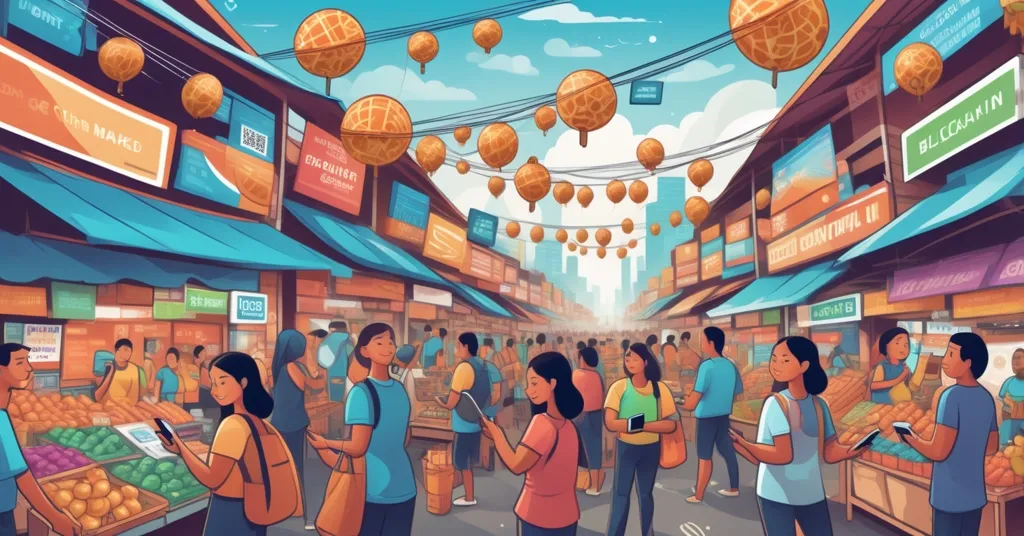Philippines Smashes 2024 Digital Payment Goals: Blockchain Next?

Philippines Surges Past 2024 Digital Payment Goals: A Leap Toward Blockchain Potential?
The Philippines has achieved a remarkable feat in 2024, with digital payments overtaking traditional cash transactions and smashing national targets ahead of schedule. According to the Bangko Sentral ng Pilipinas (BSP), this milestone marks a pivotal moment in the nation’s push toward a cashless economy, driven by innovative platforms and a tech-savvy population, yet it also raises questions about privacy, inclusion, and the role of decentralized technologies like Bitcoin in this evolving financial landscape.
- Digital payments hit 57.4% of retail payment volume and 59% of transaction value in 2024, exceeding the 52–54% target.
- Government payments lead at 97.2% digitalization, while personal and business sectors show uneven adoption.
- Infrastructure and trust built here could lay groundwork for blockchain, though centralized control sparks concerns.
Digital Payment Boom: Breaking Down the Numbers
The raw data paints a picture of rapid transformation. Digital payments now account for 57.4% of monthly retail payment volume in the Philippines, up from 52.8% in 2023, and a striking 59% of total transaction value. This blows past the 52–54% target set by the Philippine Development Plan 2023–2028, signaling a faster-than-expected shift to digital channels, as reported in a recent update on Philippines digital payment achievements. BSP Governor Eli Remolona, Jr. summed it up with a nod to growing confidence in these systems:
“These figures reflect the continued shift toward digital channels and the growing trust of Filipinos in using digital financial services.”
Behind these percentages are specific transaction types fueling the surge. Merchant payments, person-to-person (P2P) transfers, and business-to-business (B2B) dealings together represent 93.2% of digital transaction volume, totaling a whopping 3.08 billion transactions in 2024. Merchant payments alone spiked by 29.1% year-on-year to 2.2 billion transactions, making up 66.4% of the digital pie. P2P transfers—think sending money to a friend via a mobile app—jumped 34.7% to 680.5 million transactions, while B2B dealings, often larger corporate payments, grew 28.1% to 205 million. For those new to the jargon, P2P is direct individual-to-individual money movement, and B2B covers company-to-company transfers, often for bulk or supply chain needs. Detailed statistics on InstaPay and PESONet growth confirm these impressive figures.
Key Drivers: Platforms Powering the Shift
Two major platforms, InstaPay and PESONet, are the engines behind this digital overhaul. InstaPay, a real-time payment system, exploded with a 67.8% increase in transaction volume and 46.3% in value, making instant transfers a daily reality for many. Picture a sari-sari store owner in Manila getting paid on the spot via a smartphone scan—that’s InstaPay in action. PESONet, geared toward larger, scheduled transactions, added a third daily settlement cycle in July 2024, smoothing out business payments even further. These aren’t just apps; they’re the scaffolding of a new financial ecosystem.
Beyond platforms, the BSP is rolling out ambitious projects to sustain momentum. Project Nexus links the Philippines with nations like India, Malaysia, Singapore, and Thailand for seamless cross-border payments—think of it as a digital bridge for faster, cheaper international transfers. Further insights on Project Nexus and its impact highlight its potential. Project Agila, a wholesale central bank digital currency (CBDC) pilot, tests a digital peso for institutional payments, akin to central bank reserves but in a digital format for big players, not everyday users. Then there’s QR Ph, a standardized QR code system, making P2P and merchant payments as easy as scanning a code at a local market stall—no cash, no hassle.
BSP Governor Remolona ties these efforts to a broader mission, emphasizing accessibility across the archipelago:
“This is more than just a continuation of past gains. It is a reaffirmation of our collective vision, of a future where every Juan and Maria, no matter where they are in the archipelago, can access and benefit from secure, reliable, and convenient financial services.”
Other economic drivers amplify this shift. Remittances, a lifeline at $33.5 billion annually (8.5% of GDP), increasingly flow through digital channels via apps like GCash and Maya, especially for the 11% of Filipinos working abroad. To understand more about platforms like Maya in digital payments, their role is pivotal. E-commerce, projected to hit $24.1 billion in 2024 with 19.6% growth, further fuels digital payment trust. Government programs like “One Town, One Product Philippines” push small and medium enterprises (SMEs) online, swelling merchant payment volumes. Add a young, connected demographic—73% smartphone penetration, 73.1% internet access—and you’ve got a recipe for a digital finance explosion.
Challenges on the Horizon: Fees, Trust, and Inclusion
Let’s not get carried away with the hype—significant hurdles remain. High transaction fees are a slap in the face for small-scale users, especially in rural areas. Paying to pay? That’s a tough sell for Filipinos still wary of digital wallets. Cybersecurity risks like phishing scams—think fake GCash links tricking users into handing over cash—erode trust. Internet penetration in rural zones hovers around 60%, and device access plus financial literacy gaps mean the unbanked aren’t jumping on board overnight. For deeper perspectives on challenges like high fees and trust issues, the barriers are clear. BSP Deputy Governor Mamerto Tangonan cuts to the heart of the issue:
“Our deeper challenge [is] to ensure that digital payments are not just adopted but be integrated into the daily lives of every Filipino.”
The BSP is countering with regulatory muscle—mandating licenses for payment providers, setting strict governance for clearing operators, and pushing affordability. A recent BSP report doesn’t mince words on the stakes:
“Safety in payments, whether digital, physical or cross-border, is non-negotiable.”
Financial inclusion is the ultimate target in a fragmented nation where the unbanked and underserved remain a stubborn challenge. Digital wallets, with 258 million active accounts as of 2022, help, but fraud and interoperability issues persist. Historically lagging behind ASEAN peers like Singapore, the Philippines’ catch-up is impressive, but rural connectivity and education must keep pace. Community discussions on digital payment growth challenges reflect ongoing concerns. And let’s be blunt: every digital transaction is another data point for centralized oversight. Privacy hawks, take note—this isn’t the freedom Bitcoin promises.
Crypto Connection: Stepping Stone or Stumbling Block?
While the BSP’s focus is on traditional digital payments, the infrastructure and trust being built could be a launchpad for blockchain and cryptocurrency adoption—or a barrier. CBDC pilots like Project Agila mirror digital currency trends but lack Bitcoin’s censorship resistance. A digital peso sounds slick until you realize it’s a leash, not liberation, unlike Bitcoin’s permissionless ethos. Cross-border frameworks like Nexus echo the borderless spirit of crypto, yet centralized control raises red flags for privacy and autonomy, core pillars of the decentralization we champion. Academic resources exploring blockchain adoption trends in the Philippines provide further context.
Look at remittances: traditional channels charge 5–7% fees, a gouge Bitcoin’s Lightning Network could slash to pennies if integrated into platforms like GCash. But regulatory skepticism looms—past BSP warnings on Bitcoin and strict oversight of local exchanges like Coins.ph show a cautious stance. Contrast this with blockchain’s security edge: immutable ledgers could thwart phishing scams plaguing digital wallets, though losing a private key is its own disaster. And for rural areas? Bitcoin’s offline transaction potential via SMS or radio could bridge access gaps, though education and scalability remain sticking points. Insights on Bitcoin’s potential in remittances underline these possibilities.
The Philippines’ tech-savvy youth—73% with smartphones—could drive grassroots Bitcoin adoption faster than CBDCs if given tools and knowledge. As a Bitcoin maximalist might argue, centralized CBDCs are just fiat 2.0—polished, but still shackled. Still, we can’t ignore altcoins and DeFi filling niches Bitcoin doesn’t touch. Ethereum-based stablecoins, for instance, could stabilize remittance flows where Bitcoin’s volatility spooks users. The digital payment surge is a win, but it’s a half-step. True financial sovereignty, the kind Bitcoin maximalists fight for, demands more than slick apps—it needs unstoppable, private systems.
Historically, the Philippines has had a rocky crypto journey. Early BSP caution clashed with growing interest via platforms like Coins.ph, and while this payment boom aligns with fintech growth, it diverges from true decentralization. Post-COVID necessity accelerated digital adoption, but will it pave the way for DeFi, or just tighter central control? That’s the million-peso question. BSP Governor Remolona offers a guiding principle that crypto enthusiasts can partly cheer:
“We recognize that innovation is not an end in itself, but a powerful means to reach people, especially the unbanked and underserved, with tools that uplift lives.”
What’s Next for the Philippines?
Projections paint an optimistic future—digital payment users could top 60 million by 2027, over half the population, with real-time transactions hitting 1.54 billion by 2028. But universal adoption hinges on slashing fees, bolstering security, and wiring rural regions. For crypto advocates, the BSP’s rails are a double-edged sword: useful for onboarding the masses, yet a reminder that centralized systems often trade freedom for efficiency. The fight for a decentralized financial revolution—private, borderless, and unstoppable—still has ground to cover. Personal experiences shared on how digital payments impact financial inclusion offer a grounded view on this transition. Let’s hope the Philippines’ payment revolution leaves room for that kind of disruption, because swapping one gatekeeper for another isn’t progress—it’s just a shinier cage.
Key Takeaways and Questions
- What’s the status of digital payments in the Philippines?
They’ve surged to 57.4% of retail payment volume and 59% of transaction value in 2024, surpassing the national target of 52–54%. - Which sectors are leading this digital transition?
Government payments are nearly fully digital at 97.2%, personal transactions reach 72.2% by volume, while businesses lag in volume at 19.8% but grow in high-value deals at 38.6%. - What initiatives are driving this change?
Platforms like InstaPay (67.8% volume growth) and PESONet, cross-border projects like Nexus, CBDC trials like Agila, and QR Ph enhancements are key catalysts. - What challenges hinder full digital payment adoption?
High fees, cybersecurity threats like phishing, trust gaps, rural connectivity issues (60% internet penetration), and the need for habitual use are major obstacles. - How does this tie into blockchain and crypto adoption?
Digital payment infrastructure could accelerate Bitcoin or DeFi use for remittances and security, but centralized CBDCs and oversight raise privacy concerns versus Bitcoin’s decentralized ethos. - Could Bitcoin solve the Philippines’ digital payment woes?
Potentially—Bitcoin’s low fees via Lightning Network and offline capabilities could help remittances and rural access, though regulatory hurdles, volatility, and education gaps pose challenges.



